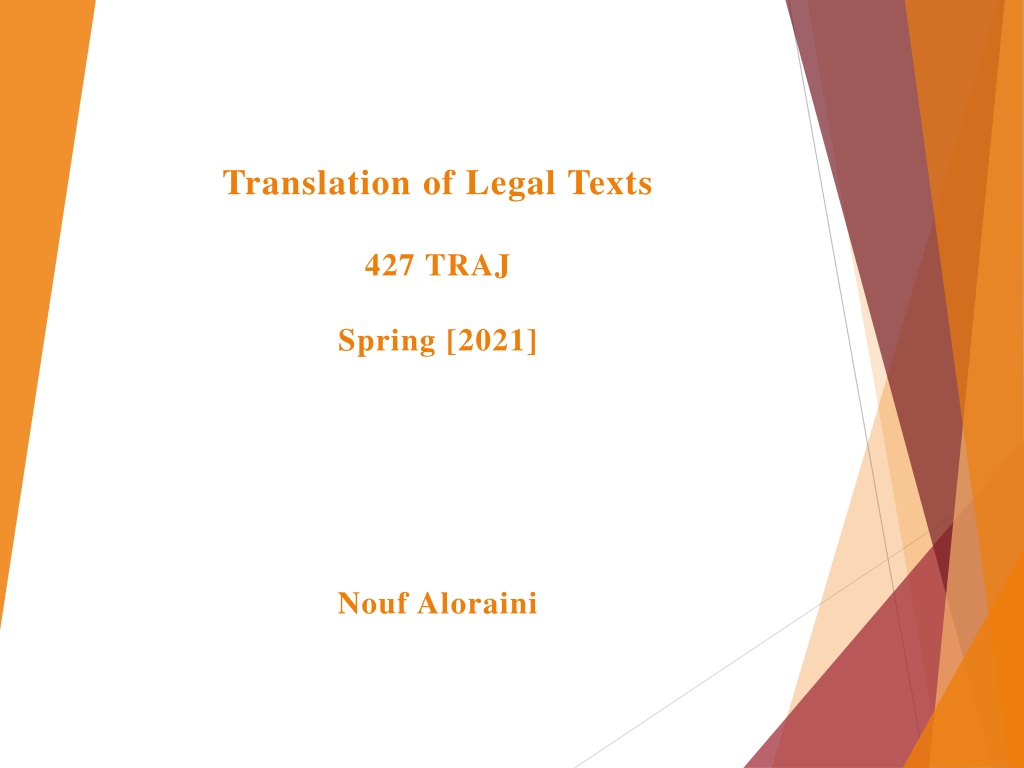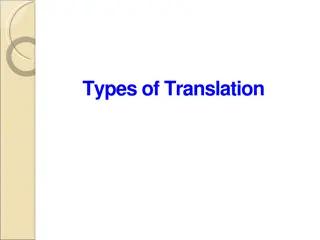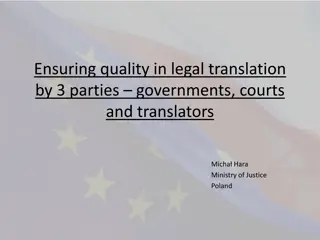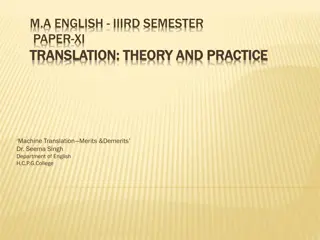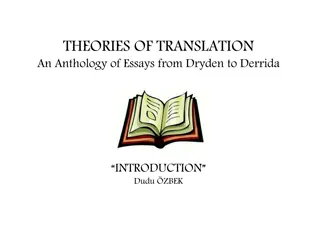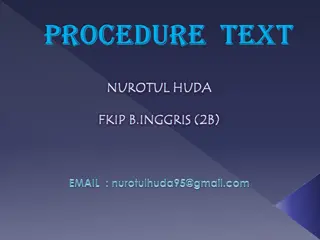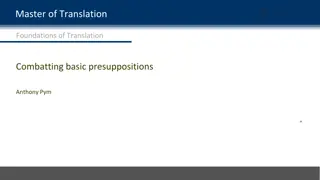Translation of Legal Texts Course Overview
This course provides a comprehensive overview of translating legal texts from English into Arabic and vice versa. Students will explore various types of legal texts, specialized terminology, and resources essential for accurate translation. The course covers the history of legal discourse, emphasizing the importance of legal translation in the context of globalization and international organizations. Attendance, assessments, and course objectives focusing on linguistic, stylistic, and pragmatic features of legal texts are outlined.
Download Presentation

Please find below an Image/Link to download the presentation.
The content on the website is provided AS IS for your information and personal use only. It may not be sold, licensed, or shared on other websites without obtaining consent from the author. Download presentation by click this link. If you encounter any issues during the download, it is possible that the publisher has removed the file from their server.
E N D
Presentation Transcript
Translation of Legal Texts 427 TRAJ Spring [2021] Nouf Aloraini
1. Introduction to the Course
Course Description: In this course, students are expected to cover a wide range of texts pertaining to the legal domain and its sub-domains. The main focus will be placed on resolving the various problems and difficulties encountered in these domains, with a special focus on terminology, lexical borrowing and coinages, abbreviations and acronyms, and Arabization.
Course Objectives: Knowledge of the different types of legal texts and the features specific to each type. Translating specialized legal texts from English into Arabic and vice versa which involves: Knowledge of the lexical, syntactic, pragmatic, stylistic, and textual features of the legal register/genre and how to deal with these features in translation. Knowledge of specialized legal terminology and expressions and their equivalents in the TL. Being familiar with different resources (e.g., websites and dictionaries) that assist in the translation process.
Course Requirements: 30% online quizzes, participation, and assignments. 30% first in-term exam 40% final exam
Attendance: Attending both online and (if things are back to normal) in-person classes is very important. Attendance will be recorded either way. Absence warning: 25% and above. Banning from the final exam: 25% and above.
2. History of Legal Discourse
Within English French and Latin were the languages of education. Legal English began as a combination of English, French, and Latin. French became the language of law with Latin terms and word order being used to make legal language more complicated. A law was passed in 1731 for English to be used as the language of the law but the influence of French and Latin remained. Legal translation gained importance in the 20th century with globalization and the establishment of international organizations (e.g., the UN).
Within Arabic Legal discourse in Arabic dates back to Babylon. With the rise of Islam, the Holy Qur an set the laws for Muslims. The Prophet Peace be Upon Him and some of the Caliphates that followed him signed treaties with different peoples.
Legal language is a kind of specialized or technical language LSP (language for special purposes OR Language for Legal Purposes LLP ). Legal language may be incomprehensible even to proficient language users because knowledge of the legal system is necessary. Legal language only makes sense within the context of the legal system. Legal language is a register (i.e., a variety of language) used for legal situations. The legal register shares some features with ordinary language, but it has features that are specific to legal language as a technical language. Legal language has a performative nature (i.e., Speech Act Theory), for example, You are guilty , You are fined 1,000 SR , testifying, contracts, wills, marriage ceremonies.
1. Legislative texts (e.g., international treaties , laws produced by lawmaking authorities, constitutions) 2. Judicial texts (e.g., texts produced during judicial processes by judicial officers or legal authorities, cases, legal reports, court rulings or verdicts) 3. Legal scholarly texts (e.g., texts produced by academic lawyers or legal scholars) 4. Private legal texts (e.g., texts written by lawyers such as contracts, deeds, and wills; and also texts written by non- lawyers such as private agreements and witness statements documents written for legal purposes).
5. Features of Legal Language
1- Lexical Features Translators need to be careful because not all terms/expressions have equivalents in the TL. The vocabulary of legal language is complex and unique. It is a universal feature of all legal languages. For example: Archaic words (e.g., hereby, thereby, aforesaid, hereof, said) Foreign words (e.g., lesser, lessee, bona fide, ipso facto, court, evidence, jury, property) Formal usage (e.g., shall, may, your honor, His Royal Highness, I solemnly swear .) Formulaic expressions Very specific and precise wording Special use of capitalization
2- SyntacticFeatures Translators need to be aware of the special syntactic features of legal language because they may create comprehension barriers. Legal language is formal, impersonal, complex, and lengthy. Sentences are usually longer in legal texts compared to other types of texts. Some syntactic features: Nominalization using a noun instead of its verb Long and complex sentences Passivization to emphasize the formal, impersonal style of legal writing Binomial expressions/doublets and triplets words that are synonyms or near-synonyms that commonly occur together.
3- PragmaticFeatures Legal language is performative in nature. Words in legal language have different meanings and effects depending on who uses them and in which context. For Example: Performative models that express implicit speech acts (e.g., may for permission, may not for prohibition, shall for obligation, and shall not for prohibition) Performative verbs that express explicit speech acts (e.g., declare, announce, promise, undertake, enact, confer, amend, certify, confirm).
4- StylisticFeatures Legal language is characterized by an impersonal, formal style. Different types of legal language have their own characteristics of legal style.
5- TextualFeatures Texts are divided into sections and subsections with headings and subheadings Some types of legal texts include a section for definitions (i.e., contextual meaning is essential in such documents) Some cohesive devices are commonly used in legal language. For example: Lexical repetition to avoid using pronouns if their use will cause ambiguity. Ordinary pronouns and demonstratives are usually avoided especially if they may cause ambiguity and are replaced by other words (e.g., hereunder, hereafter, herein, aforesaid, such, said)
6. The Plain Language Movement
The Plain Language Movement was a movement that aimed to make legal language more accessible to the layman. It called for: Replacing archaic, rarely used, and foreign words/terms/expressions with those closer to everyday use Removing unnecessary words and expressions Reducing sentence length Reducing the use of passive voice constructions Reducing the use of nominalization Ensuring the text is gender-neutral Replacing shall with must, the construction is/are to (e.g., There is to be a regulations .), or the present simple tense For further information read the relevant articles on Blackboard.
7. Legal Translation within Translation
Types of Translation General Translation Literary Translation Specialized/Technical Translation Legal Translation Specialized/technical translation LSP (language for special purpose LLP )
Legal translation is the rendering of legal texts from the SL to the TL. It is the translation of texts used in law and legal settings Types of legal translation: 1. Legal translation for normative purposes: Both texts have equal legal force (e.g., legal texts in bilingual jurisdictions such as Canada and Hong Kong, multilingual legal instruments of the UN, multilingual laws of the EU) 2. Legal translation for informative purposes: Only the ST has legal force. (e.g., the translation of different legal documents for the purpose of informing target readers) 3. Legal translation for general (judicial) purposes: Translation of documents used in court proceeding or as evidence
Legal translation is generally considered difficult for the following reasons: Different legal systems have different laws 1. Linguistic differences between the SL and TL 2. Cultural differences between the cultures of the SL and TL 3.
Requirements of a legal translator: 1. Basic knowledge of the legal systems of both SL and TL 2. Familiarity with relevant legal terminology in SL and TL 3. Competence in TL legal writing style
10. Translating Legal Language
Shall shall , shall : shall
Amoco shall be exempted from all custom duties. . The Life Insured shall pay to the Insurance Company every subsequent premium in due time. .
May may may not may :
The Landlord may enter the property without the Tenant s consent in case of emergency. . The Contractor may not assign the contract to a third party without the prior written consent of the Employer. .
Here/There + Preposition Using here + preposition is a feature of legal language. It functions like a demonstrative and refers to the document in which it occurs (e.g., contract, agreement, treaty). Hereto, hereby, hereunder, hereof, herewith, herein, hereafter, hereinabove Mr. Ahmad hereinafter referred to as the First Party / ... Both parties hereby agree to the following: :
Using there+ preposition is a feature of legal language. It functions like a demonstrative and refers to the person, item, or situation just mentioned. Thereto, thereof, thereby, therewith, therefor, therein The bank or any branch thereof The Agent shall have the right to open bank accounts and withdraw and deposit therein.
Anaphoric Devices Anaphoric devices are pronouns and demonstratives. Some strategies are followed to avoid using anaphoric devices because using them may cause ambiguity. Some of these strategies are: 1. Repetition 2. Using which + repeating the word 3. Replacing the anaphoric device with such, said, or the same 4. Using gender-free it instead of using a feminine or masculine pronoun If no ambiguity occurs, anaphoric devices may be used with care.
Repetition 1. The Tenant shall pay to the Landlord at his office ... The Tenant shall pay to the Landlord at the office of the Landlord ...
Using which + repeating the word 2. Any dispute between Aramco and the Company shall be settled by arbitration, which arbitration shall take place at the Department of Contracts in Aramco. .
Replacing the anaphoric device with such, said, or the same 3. Such and Said to replace demonstratives If the Contractor incurs any further costs, then the Employer shall take such costs into consideration. . The said Party hereby agrees to purchase said premises with said amount of 100,000 SR. . 100000 .
The same to refer to a word/sentence previously mentioned in the text The Tenant shall pay all the taxes regularly levied and assessed against the premises and keep the same in repair. .
Using gender-free it instead of using a feminine or masculine pronoun 4. Borrower shall comply with all of its covenants to Bank set forth in and arising from the Loan Agreement. .
The Proviso Clause The proviso clause is the expression provided that and it is a conditional. It is translated into Arabic using an expression that provides the same meaning of condition, such as:
Example: The Landlord shall have the right, subject to the Tenant s consent, to enter the dwelling to inspect the premises provided that the Landlord may enter the dwelling without the Tenant s consent in case of emergency. .
Capitalization in Legal Language In legal usage, some common nouns referring to parties in an action, to judicial bodies or to the names of documents are capitalized: Counsel for the Plaintiff the said Notary The Court (meaning the judge) sustained the objection. the aforementioned Agreement.
Capitalization in Legal Language Capitalize the official names of treaties, agreements, legal codes, pieces of legislation and other official documents, as well as their official short forms: the Treaty of Versailles the Financial Administration Act Order-in-Council P.C. 1354.
: : (2000) Cao, D. (2007). Topics in translation: Translating Law. UK: Multilingual Matters Ltd. El-Farahaty, H. (2015). Arabic-English-Arabic legal translation. UK: Routledge. Hatim, B. (1997). English-Arabic/Arabic-English translation: A practical guide. London: Saqi Books. Macmillan Dictionary (2014). Legal documents and parts of legal documents: Synonyms or related words. Retrieved July 8, 2015, from http://www.macmillandictionary.com/thesaurus-category/british/Legal-documents- and-parts-of-legal-documents Williams, C. (2011). Legal English and plain language: An update. ESP Across Cultures, 8, 139-151.
